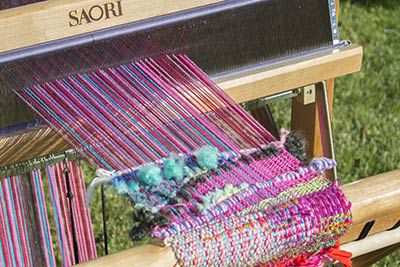Wabi-Sabi is an aesthetic philosophy which originated in Japan. Kintsugi evolved from Buddhist teachings that use lacquer mixed with powdered gold, silver, or platinum to repair broken pottery. Deeply rooted in the mindset of Japanese people, both Wabi-Sabi and Kintsugi emphasizes the beauty found in imperfections, something that we often forget about. Although Misao Jo was not thinking about this philosophy while creating Saori, her technique certainly fits in that notion.
Saori’s accidental invention happened in 1960’s, after 57 year old Misao build herself a loom and started weaving as a hobby. One day, while making an obi, a wide belt used to wear kimonos, the woman discovered that one of the warp threads was missing, which resulted in an interesting pattern on the belt’s surface. Excited Misao decided to show her creation to the director of weaving factory in her neighborhood, however, she definitely didn’t expect that the man would call her work “worthless”. Still, Jo didn’t allow it to stop her. Understanding that commercial factory will never want to manufacture something “flawed”, the woman decided to stand by hand-weaving and kept on making more “worthless” obi belts. Her unique work was finally noticed by an owner of obi shop in Shinsaibashi Street, Osaka, famous for a number of exquisite and expensive boutiques. The owner was astonished with the beauty of Jo’s design, praising its creativity and uniqueness. This faithful encounter convinced Misato that her technique can revolutionize the world and gave her a confidence boost. She started by giving away hand-woven items to her friends and acquaintances, who in turn would come back to learn how to Saori. Now, at 102, Misato Jo is as lively as ever, still teaching people about weaving and the importance of being unique: “All flowers are beautiful, even though each individual flower is different in form and color. Because of this difference, “all are good”. Because everything has the same life, life cannot be measured by a yardstick. It is this individuality that makes everything meaningful and the uniqueness of each thread that creates the tapestry of life.” she says, always smiling.

The charm of Saori lays in its easiness. As a free-style technique, the only rules or samples to follow are made by the weavers themselves. Saori encourages the undisturbed flow of creativity and self-expression, understanding that every cloth freely woven by people with different personalities is beautiful in a different way. While mistakes may appear, they are not treated as such – rather perceived as a part of the creation process and thus accepted. After all, this technique is more about the weaver’s self-exploration rather than aesthetics.


The philosophy of Saori is described in a four simple steps:
1. Consider the differences between machines and people.
2. Let’s adventure beyond our imagination.
3. Let’s look out through eyes that shine.
4. Let’s learn from everyone in the group.
“The “SA” of SAORI has the same meaning as the first syllable of the word “SAI” which is found in Zen vocabulary. It means everything has its own individual dignity. And the “ORI” means weaving.” Misao explains, revealing the true meaning of this technique. It can be used not only to relive one’s stress, but also as a part of a therapy for the disabled. Saori carries an extremely positive message of self-acceptance and love for individuality. Sometimes beauty can be found in the places most unexpected – people’s hearts included.

